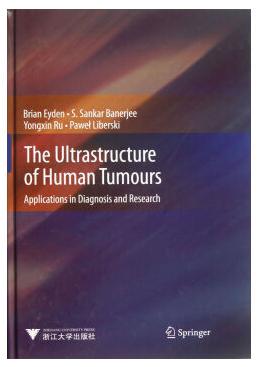人体肿瘤超威结构在其诊断及研究中的应用(英文版)
作者:[英]布莱恩•艾登,桑卡尔•巴纳吉 等 来源: 全球华人抗癌新药网 发布时间:2016-09-18

基本信息
作者:[英]布莱恩•艾登,桑卡尔•巴纳吉,帕维尔•利伯斯基 等
出版社:浙江大学出版社
ISBN:9787308106269
版次:1
商品编码:11325180
包装:平装
开本:16开
出版时间:2013-06-01
用纸:胶版纸
页数:680
正文语种:英文
内容简介
《人体肿瘤超威结构在其诊断及研究中的应用(英文版)》是一本关于人体肿瘤超威结构的图集。基于电镜病理学,囊括了在临床上给病理医生带来很大诊断困难的良性胎记瘤和软组织肿瘤的相关图片,旨在帮助肿瘤病理医生作出诊断更精确;收录了最新肿瘤变体的超威结构图,这是此前相关亚显微结构病理学专著中所未出现过的;深入探究肿瘤细胞的结构及功能,帮助肿瘤研究者更好理解肿瘤细胞分化与细胞行为。《人体肿瘤超威结构在其诊断及研究中的应用(英文版)》的图片均取材于人体肿瘤的活检标本,每幅图均配有图例说明。每个章节包括三大块内容:1~2页的介绍性或说明性文字、配有图例说明的图片以及方便读者获取信息的表格。此外,书后附有参考文献,供读者进一步阅读及研究之用。
目录
1 Introduction 1.1 IntroductoryRemarks
1.2 Electron Microscopy Applied to Tumors
1.3 ImpactandLimitations ofImmunohistochemistry
1.4 Value ofElectron Microscopy in Addition to Diagnosis.
1.5 Intellectual Basis for Tumour Diagnosis by Electron Microscopy.
1.6 Technique
1.6.1 Tissue Handling and Reagent Preparation
1.6.2 Electron Microscopy Procedure
1.6.3 Dewaxing for Electron Microscopy
1.7 AssessingtheQuality ofPreservationin Semi—thin Sections
1.8 Distinguishing Reactive from Neoplastic Cells
l.8.l Vessels
1.8 2 Mv0fibroblasts
1.8.3 StriatedMuscleCells
References
2 Epithelial Tumours.
2.1 Introductory Remarks
2.2 The Core Features ofEpithelial Differentiation.
2.3 The Keratinocyte as the Archetypal Cell for Assessing Basal.Cell and Squamous—Cell
Difierentiation 1n Tumours
2.4 Basal—Cell and Squamous.Cell Carcinoma
2.4.1 Conventional Basal—Cell and Squamous—Cell Ca~inoma
2.4.2 Variants ofBasal.Cell Carcinoma
2.4 3 Poorly Differentiated Squamous.Cell Ca~inoma,Variants of Squamous.Cell Carcinoma,
and Related Tumours Showing Squamous Differentiation
2.5 Ultrastructural Features ofGlandular D{fTerentiation
2.5 1 Ultrastructural Architecture ofthe Normal Gland
2.5.2 Secretory Materials ofEpithelial Origin
2.6 Thc Ultrastructure ofAdenocarcinoma
2.6.1 General UltrastructuraI Properties ofAdenocarcinoma
2.6.2 Additional Features ofDiagnostic or Biological Interest in Selected Examples of
Adenocarcinoma and Carcinomas Showing Glandular Epithelial DifTerentimion
2.7 Tumours Showing Distinctive Specialised Forms ofEpithelial Differentiation
2 .7.1 Mesothelioma
2.7.2 Adrenocortical Tumours
2.7.3 Oncocytoma
2.7.4 Myoepithelial Cell Differentiation in Tumours
2.7.5 Neuroendocrine Differentiation in Carcinoma
References
3 Melanncytic Lesions with Special Reference to Malignant Melanoma
3.1 Introductory Remarks
3.2 TheNormalMelanocyte
3.3 TheUltrastructure ofMalignantMelanoma
3.3.1 TheMelanosome
3.3.2 Ultrastmctural Features ofMalignant Melanoma in Addition to Melanosomes
3 3.3 The Ultrastructure ofMalignant Melanoma Variants
3.3.4 Tumours 0ther than Malignant Melanoma Showing Melanocytic Differentiation
Referenccs
4 Tumours ofSoft Tissue and Bone,and Other Mesenchymal Tumours。
4.1 IntroductoryRemarks
4.2 Fibroblastic and Myofibroblastic Tumours
4.2.1 The Normal Fibroblast and the Reactive Myofibroblast
4.2.2 Tumours and Tumour.Like Lesions Showing Fibroblastic Differentiation
4.2.3 Mvofibroblastic Differentiation in Tumours and Tumour-Like Lesions
4.3 FibrohistiocyticTumours
4.3.1 Giant—CellTumours
4.3.2 The Benign Fibrous Histiocytomas
4.3.3 Plexiform Fibrohistiocytie Tumour
4.3.4 The So.Called Malignant Fibrous Histiocytomas
4.3.5 Atypical Fibroxanthoma
4.4 Smooth—Muscle Tumours and Peficytic Tumours
4.4.1 TheNormal Smooth.MuscleCell
4.4.2 Leiomyoma—GlomusTumour
4.4.3 Myopericytoma/Haemangiopericytoma
4.4 4 Leiomyosarcoma
4.5 Tumours Showing Striated.Muscle Differentiation
4.5.1 The Normal Striated—Muscle Cell
4.5 2 Rhabdomyoma
4.5.3 Rhabdomyosarcoma
4.5.4 Rhabdomyoblasts in Tumours other than Rhabdomyoma and Rhabdomy
4.6 Gastrointestinal StromalTumours
4.6.1 TheInterstitialCell ofCajal
4.6.2 TheUltrastructure ofGIST
4.7 VascularTumours
4.7.l TheNoFmalVessel
4.7.2 BemgnVascularLesions
4.7.3 ConventionalAngiosarcoma
4.7.4 EpithelioidAngiosarcoma
4.7.5 Epithelioid HaemangloendOthelloma
4.7.6 Kaposi’s Sarcoma
4.8 AdipocyticTumours
4..8.1 TheNormalAdipocyte
4.8 2 BenignAdipocYticTumors
4.8 3 Liposarcoma
4 9 Tumours Showing Cartilaginous,Osteogenic and Notochordal Differentiation
4.9.1 NormalCells ofCartilage andBone
4.9.2 Benign Chondroblastic Lesions
4.9 3 Chondrosarcoma and Other Cartilaginous Tumours
4.9 4 Notochordal Tumours
4.9.5 Osteosarcoma and Other Osteogenic Tumours
4.10 Tumours Showing Complex or Uncertain Differentiation
4.10 l Ossifying Fibromyxoid Tumour
4.10 2 Mixed Tumour/Myoepithelioma
4.10 3 Synovial Sarcoma
4.10 4 Epithelioid Sarcoma
4.10.5 Alveolar Soft.Part Sarcoma
4.10.6 Desmoplastic Small.Round,Cell Tumour
4.lO 7 Malignant Rhabdoid Tumour
Refefences
5 Lymphoma and Leukaemia
5.1 IntroductoryRemarks
5 2 Normal (Reactive) Haematolymphoid Cells.
5.2.1 Lymphocytes
5.2.2 Centroblasts and Centrocytes
5.2.3 PlasmaCells
5.2.4 Monocytes.Macrophages,Langerhans Cells and Multinucleated Giant Cells
5.2.5 MastCells
5.2.6 EosinoDhils
5.2.7 Neutrophils
5.2.8 Basophils
5.2.9 Megakaryocytes andPlatelets
5.2.10 Erythroblasts f‘normoblasts’and‘normocytes’)
5.3 Haematolymphoid Neoplasia
5.3.l Myeloproliferative Neoplasms
5.3.2 TheAcuteLeukaemias,
5.3.3 B,CellNeoplasms
5.3.4 T—CellNeoplasms
5.3.5 HodgkinLymphoma
5.3.6 Tumours Showing Histiocytic Differentiation—Dendritic Cell Tumours
5.3.7 ReticulumCellTumours
References
6 Tumours ofthe Central Nervous System
6.1 Introductory Remarks
6.2 AstrocyticTumours
6.21 Astrocytoma
6.2 2 Glioblastoma
6.2.3 Pilocytic Astrocytoma.
6.2 4 PilomyxoidAstrocytoma
6.2.5 Pleomorphic Xanthoastrocytoma
6.2 6 MonomorphousAngiocentricGlioma
6.2 7 Subependymal Giant.Cell Astrocytoma ofTuberous Sclerosis
6.3 Oligogodendroglioma
6.4 Ependymoma and Subependymoma
6.5 Choroid Plexus Tumours.
6.6 MixedNeuronal andGilalTumours
6.6.1 Gangliocytoma and Ganglioglioma
6.6.2 Desmoplastic Infantile Ganglioglioma/Desmoplastic Cerebral
Astrocytoma ofInfancy or Desmoplastic Infantile Astrocytoma
6.6.3 Angioganglioglioma
6.6.4 Dysembryoplastic Neuroepithelial Tumour
6.6.5 CentralNeurocytoma
6.6.6 Extraventricular Neurocytoma
6.6.7 Papillary Glioneuronal Tumour
6.6.8 Glioneuronal Tumour with Neuropil.Like Islands/Rosetted Glioneuronal Tumour
6..6.9 Rosette—Forming Glioneuronal Tumour ofthe IV Ventricle
6.7 PinealParenchymaTumours
6.7.1 Pineocytoma
6.7.2 PPT ofIntermediate Difierentiation
6.7.3 Pineoblastoma
6.7.4 PapillaryTumour ofthePinealRegion
6.8 EmbryonalTumours
6.8.1 Medulloepithelioma
6.8.2 Ependvmoblastoma
6.8.3 Medulloblastoma
6.8.4 Atypical Teratoid/Rhabdoid Tumour
6.8.5 Melanotic Neuroectodermal Tumour ofInfancy
6.9 Meningioma and Meningioangiomatosis
6.10 Intracranial Germ Tumours
6.10.l Germinomas
6.10.2 Yolk SacTumour
6.lO 3 EmbryonalCarcinoma
6.10.4 Choriocarcinoma
6.11 Craniopharyngioma
6.12 Paraganglioma
6.13 Cerebellar Liponeurocytoma
Acknowledgements
References
7 Tumours of the Nenroendocrine System and the Peripheral Nervous System
7.l IntroductoryRemarks
7.2 The Ultrastructure ofNeuroendocrine Tumours
7.2.1 The Archetypal Neuroendocrine Granule
7.2.2 Vafimions in the Structure ofNeuroendocrine Granules in Different Neuroendocfine
TumOurs.and Additional Ultrastructural Features ofNeuroendocrine Tumours
7.3 Tumours ofthe PeripheralNervous System
7.3.1 TheNormalNeuron
7.3.2 Extracranial Tumours Showing Neuronal/Glial/Ganglionic Differentiation
7.3 3 TheNormalNerve Sheath
7.3 4 Tumours oftheNerve Sheath
7.4 Meningioma
References
8 Miscellaneous Tumours and Tumour.Like Lesions
8.1 Introductory Rema~s.
8.2 Tumours ofthe Male and Female Reproductive Tracts
8.2.1 Seminoma
8.2 2 Embryonal Carcinoma
8 2.3 Endodermal Sinus Turnout(Yolk Sac Tumour)
8.2 4 Choriocarcinoma
8.2 5 Tumours Showing Leydig—Cell Differentiation
8.2 6 Tumours Showing Sertoli—Cell Differentiation
8.2.7 Tumours Showing Granulosa.Cell Differentiation
8.3 BlastemalTumours
8.3 1 Wilms’Tumour fNephroblastoma)
8.3 2 Pulmonary and Pleuropulmonary Blastoma
8.3 3 Hepatoblastoma
8.3 4 Pancreatoblastoma
8.4 Embryonal Sarcoma ofLiver
8.5 Juxtaglomerular Cell Tumour
8.6 CardiacMyxoma.
8.7 Pneumocytoma(Sclerosing Haemangioma of Lungl)
8.8 Cellular Neurothekeoma
8.9 Amyloidoma
8 10 Malakoplakia
8.11 Bacillary Angiomatosis and Mycobacterial Spindle—Cell Pseudotumour
8.12 Rosai—Dorfman Disease
References
Index
